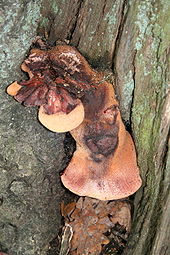- Fistulina hepatica
-
"Beefsteak mushroom" redirects here. This name can also refer to the potentially lethal Gyromitra esculenta..
Fistulina hepatica Beefsteak fungus Scientific classification Kingdom: Fungi Phylum: Basidiomycota Class: Basidiomycetes Order: Agaricales Family: Schizophyllaceae Genus: Fistulina Species: F. hepatica Binomial name Fistulina hepatica
(Schaeffer)Fistulina hepatica Mycological characteristics 
pores on hymenium 
cap is flat 
hymenium is decurrent 
stipe is bare 
spore print is pink 
ecology is parasitic 
edibility: edible Fistulina hepatica (Beefsteak Fungus, also known as Beefsteak Polypore or Ox Tongue) is an unusual bracket fungus classified in the Agaricales, that is commonly seen in Britain, but can be found in North America, Australia, North Africa, and the rest of Europe. As its name suggests, it looks remarkably similar to a slab of raw meat. It has been used as a meat substitute in the past, and can still be found in some French markets. It has a sour, slightly acidic taste. For eating it must be collected young and it may be tough and need long cooking.
Contents
Details
The shape resembles a large tongue, and it is rough-surfaced with a reddish-brown colour. The spores are released from minute pores on the creamy-white underside of the fruit body. A younger Fistulina hepatica is a pinkish-red colour, and it darkens with age. It bleeds a dull red juice when cut, and the cut flesh further resembles meat.[1]
The underside of the fruiting body, from which the spores are ejected, is a mass of tubules. The genus name is a diminutive of the Latin word fistula and means "small tube", whilst the species name hepatica means "liver-like", referring to the consistency of the flesh.
The species is fairly common, and can often be found on oaks and sweet chestnut, from August to the end of Autumn, on either living or dead wood. In Australia, it can be found growing from wounds on Eucalyptus trees. It causes a brown rot on the trees which it infects.[2]
Relationship to other fungi
In the past, Fistulina was placed in its own family, Fistulinaceae,[3] but now molecular studies have led to its placement with the seemingly very different agaric mushroom Schizophyllum in the Schizophyllaceae.[4] In fact Fistulina is a cyphelloid genus, meaning that it is closely related to gilled fungi, but its fertile surface consists of smooth cup-shaped elements instead of gills. The underside (the hymenium) is a mass of tubules which represent a "reduced" form of the ancestral gills.
References
- ^ N. Arlott, R. Fitter and A. Fitter, Collins Complete Guide: British Wildlife ISBN 1-85927-092-1
- ^ Funga Nordica. Copenhagen: Nordsvamp. 2008. p. 40 & 250..
- ^ Bon, Marcel. The Mushrooms and Toadstools of Britain and North-Western Europe Publisher=Hodder & Stoughton. ISBN 0-340-39935-X..
- ^ See the following two journal references for molecular evidence of the family relationship: "One hundred and seventeen clades of euagarics". Molecular Phylogenetics and Evolution (Amsterdam: Academic Press (Elsevier)) 23: 357–400. 2002. doi:10.1016/S1055-7903(02)00027-1. PMID 12099793. http://www.umich.edu/~mycology/publications_assets/moncalvo.mpe.2002.pdf., "Evolution of complex fruiting-body morphologies in homobasidiomycetes". Proceedings of the Royal Society B (London: The Royal Society) 269: 1963–1969. 2002. doi:10.1098/rspb.2002.2123. PMC 1691125. PMID 12396494. http://www.pubmedcentral.nih.gov/articlerender.fcgi?tool=pmcentrez&artid=1691125.
External links
- healing-mushrooms.net Description, bioactive compounds and medicinal properties
Categories:- Agaricales
- Fungi of Australia
- Fungi of Europe
- Fungi of North America
- Edible fungi
- Meat substitutes
- Agaricales stubs
Wikimedia Foundation. 2010.


